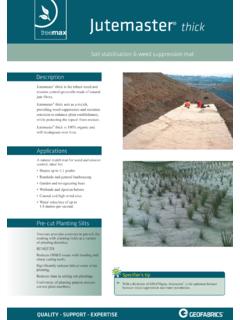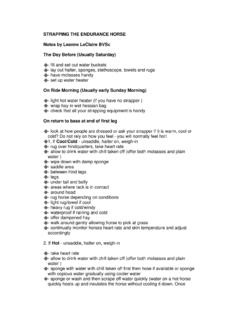Transcription of HOW TO USE LATEX MOULDS FOR CONCRETE - …
1 HOW TO USE LATEX MOULDS FOR CONCRETE This a brief overview of the methods of CONCRETE casting to get you up and running. For more in depth information ask for our e-Book on the subject. The commonly used term CONCRETE casting as it applies here refers to a mixture of sand, Portland cement and water. In contrast, building CONCRETE more commonly contains additional amounts of an aggregate such as blue metal or gravel. Our mix is designed to be fluid and decorative and capable of being poured into MOULDS rather than structurally strong and load bearing. The larger MOULDS as used for garden decoration must be well supported due to the weight of the sand and cement mixture. A fiberglass back-up mould must be used with most of the larger MOULDS to encase and thus support the LATEX mould, to ensure the casting has a perfect shape.
2 (unsupported LATEX is elastic and will stretch out of shape). An alternative with the smaller MOULDS is to support the mould upside down in a sand box. The sand should be moist so that it stays in shape but does not distort the mould. Another method is suspend the mould in a bucket of water or sawdust. When using a sand box, half fill the mould and then squeeze it to push the cement/sand mix into every corner of the mould before setting back in the sand box, packing the damp sand around the mould to just under the top. Continue filling the mould with the cement mix. We make recommendations with our garden MOULDS as to whether a back-up mould is essential, advisable or not necessary. Back-up MOULDS can be made to order for all MOULDS , ring for details.
3 EQUIPMENT REQUIRED A plastic mixing tub or a wheelbarrow for larger projects A shovel, spade or trowel Mould release. Use a vegetable oil (machine or car oil affects the LATEX ) Dust mask, rubber gloves, plastic sheeting MIXING THE SAND AND CEMENT Mix 2 parts of sharp sand to one part of fresh Portland cement then add water and stir till you get a thick creamy mix. Alternatively, purchase a bag of ready mixed sand and cement from your local hardware store and proceed as above. The mix must be pourable, not too watery or too dry. POURING THE MOULD Fill the mould about three quarters full and then squeeze to get rid of all the air bubbles. Prod the mix in the mould with a stick in an up and down action to bring any bubbles to the surface and ensure all sections of the mould are fully covered with the mix.
4 Continue filling and the prodding action till the mould is full. To ensure all the air bubbles have gone gently lift and tap the mould or the sand box on the bench for 10 to 20 seconds. Professionals would be using a vibrating table to do the same thing. WHEN TO REMOVE THE MOULD Cover with a plastic sheet and set aside out of the sun in a cool location for 24 hours to harden. Extra time may be necessary in winter. At the end of this period remove the mould from the back-up mould or the sand box, lubricate the outside of the mould with warm water and soap or dish washing liquid and then pull the mould from the casting. CURING THE CASTING To allow the casting to fully cure and reach maximum strength cover it with cloth or hessian and keep it damp with a sprinkler for one week.
5 Keep it out of the sun during this period, in a cool damp spot. Copyright Aldax Enterprises Pty Ltd 2008





